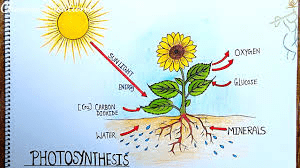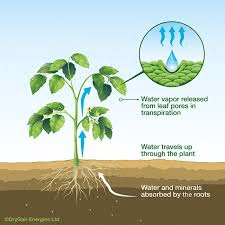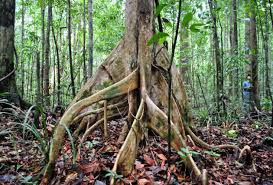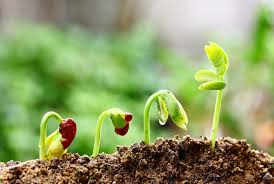Plant biology is the study of plants, their structure, functions, growth, and development. Plants are essential to life on Earth because they produce oxygen, food, and other resources that all living organisms need to survive.
Understanding the basic concepts of plant biology helps us appreciate how plants contribute to our ecosystem and support human life. This article will guide you through the key aspects of plant biology, including cell structure, photosynthesis, plant growth, and the transport of water and nutrients.
Cell Structure and Function in Plants
Plants, like all living organisms, are made up of cells. However, plant cells have unique features that set them apart from animal cells. Understanding these structures is crucial for understanding how plants function.
1. Cell Wall: Unlike animal cells, plant cells have a rigid cell wall made of cellulose. The cell wall provides structure and support, helping the plant maintain its shape. It also protects the cell and helps it withstand the pressure from the inside and outside.
2. Chloroplasts: Chloroplasts are the structures where photosynthesis occurs. They contain chlorophyll, a green pigment that captures light energy from the sun. Chloroplasts convert this light energy into chemical energy, which the plant uses to grow and produce food.
3. Vacuole: The vacuole is a large, central sac filled with fluid that stores nutrients and waste products. It also helps maintain the cell’s turgor pressure, which keeps the plant upright and firm.
4. Nucleus: The nucleus is the control center of the cell, containing the plant’s genetic material (DNA). It regulates the activities of the cell, including growth, metabolism, and reproduction.
5. Cytoplasm: The cytoplasm is a jelly-like substance that fills the cell and holds the organelles in place. It is the site of many metabolic reactions that are essential for the cell’s survival.
Photosynthesis: The Powerhouse of Plants

Photosynthesis is the process by which plants produce their food. This process is fundamental to life on Earth, as it provides the energy that fuels nearly all living organisms.
1. Light Absorption: Photosynthesis begins when chlorophyll in the chloroplasts absorbs light energy from the sun. This energy is used to split water molecules (H2O) into oxygen (O2) and hydrogen (H).
2. Oxygen Release: The oxygen produced during the splitting of water is released into the atmosphere as a byproduct. This oxygen is what we and other animals breathe to survive.
3. Energy Conversion: The hydrogen and electrons released from water are used to convert carbon dioxide (CO2) from the air into glucose (C6H12O6), a type of sugar. This process, known as the Calvin cycle, takes place in the stroma of the chloroplasts.
4. Energy Storage: The glucose produced during photosynthesis is stored in the plant as starch or used immediately for energy. Plants use this energy to grow, reproduce, and carry out other vital functions.
5. Importance of Photosynthesis: Photosynthesis is crucial because it is the primary source of energy for nearly all living organisms. It also helps regulate the levels of oxygen and carbon dioxide in the atmosphere, maintaining the balance necessary for life.
Plant Growth and Development
Plant growth and development involve various stages and processes that enable a plant to mature and reproduce. Understanding these processes is essential for anyone interested in plant biology or agriculture.
1. Germination: The growth of a plant begins with seed germination. When conditions are right—such as the presence of water, oxygen, and the right temperature—a seed absorbs water and swells. The seed coat breaks open, and the embryo inside begins to grow into a new plant.
2. Root and Shoot Development: The first structures to emerge from the seed are the roots and shoots. Roots grow downward into the soil, anchoring the plant and absorbing water and nutrients. Shoots grow upward, developing into stems and leaves.
3. Leaf Development: Leaves are essential for photosynthesis. As the plant grows, it produces leaves that capture light energy and produce food through photosynthesis. Leaves also play a role in transpiration, the process of water loss from the plant.
4. Flowering: As the plant matures, it may produce flowers. Flowers are the reproductive organs of the plant. They contain the male and female parts needed for fertilization, which leads to the production of seeds.
5. Fruit and Seed Production: After fertilization, the flower develops into a fruit that contains seeds. The fruit protects the seeds and helps in their dispersal. When the fruit is ripe, it releases the seeds, which can then grow into new plants, continuing the life cycle.
Read Also: Economic Advantages and Management of Fishery Resources
Water and Nutrient Transport in Plants

Plants need water and nutrients to grow and survive. These essential resources are absorbed by the roots and transported throughout the plant in a process known as vascular transport.
1. Root Absorption: Roots absorb water and nutrients from the soil. Root hairs increase the surface area for absorption, allowing the plant to take in more water and nutrients.
2. Xylem: Water and nutrients absorbed by the roots are transported to the rest of the plant through the xylem. The xylem is a network of tubes that carries water and dissolved minerals from the roots to the stems and leaves.
3. Transpiration: Transpiration is the process by which water evaporates from the leaves, creating a negative pressure that pulls more water up through the xylem. This continuous flow of water helps transport nutrients and keeps the plant hydrated.
4. Phloem: The phloem is another network of tubes that transports the products of photosynthesis, such as glucose, from the leaves to other parts of the plant. This process, known as translocation, ensures that all parts of the plant receive the energy they need to grow and function.
5. Nutrient Uptake: In addition to water, plants need nutrients like nitrogen, phosphorus, and potassium to grow. These nutrients are absorbed from the soil through the roots and transported throughout the plant via the xylem and phloem. Each nutrient plays a specific role in the plant’s health and development.
Reproduction in Plants: Seeds, Flowers, and Fruits
Reproduction in plants is a fascinating process that ensures the continuation of plant species. It primarily occurs through seeds, flowers, and fruits. Each of these components plays a vital role in the reproductive cycle.
1. Flowers: Flowers are the reproductive organs of flowering plants (angiosperms). They contain both male and female structures. The male part, known as the stamen, produces pollen, while the female part, called the pistil, contains the ovary, which houses the ovules.
2. Pollination: Pollination is the transfer of pollen from the male stamen to the female pistil. This can occur through various agents such as wind, water, insects, birds, and animals. Once pollen reaches the pistil, it travels down to the ovary, where fertilization occurs.
3. Fertilization: After pollination, the pollen fertilizes the ovules within the ovary. This leads to the formation of seeds, which contain the embryo of the next generation of plants.
4. Fruit Formation: The fertilized ovary develops into a fruit, which protects the seeds and helps in their dispersal. Fruits come in various forms, including fleshy fruits like apples and berries, and dry fruits like nuts and grains.
5. Seed Dispersal: Seeds are dispersed by various means, such as wind, water, and animals. This ensures that the seeds are spread over a wide area, reducing competition between the new plants and the parent plant.
Plant Hormones and Their Functions
Plant hormones are chemical messengers that regulate various physiological processes in plants, including growth, development, and responses to environmental stimuli.
1. Auxins: Auxins are primarily responsible for the elongation of cells in the shoots and roots. They play a crucial role in the growth of plants towards light (phototropism) and gravity (gravitropism). Auxins also promote root formation and are used in rooting powders to propagate plants.
2. Gibberellins: Gibberellins promote stem elongation, seed germination, and flowering. They are essential in breaking seed dormancy and helping seeds sprout. These hormones also play a role in the development of fruits and the growth of leaves.
3. Cytokinins: Cytokinins promote cell division and are involved in shoot and root growth. They work in conjunction with auxins to control the growth of roots and shoots. Cytokinins also delay the aging of leaves and flowers, maintaining their freshness.
4. Ethylene: Ethylene is a gas that influences the ripening of fruits and the shedding of leaves (abscission). It also plays a role in the response of plants to stress, such as drought or mechanical damage. Ethylene is commonly used in agriculture to ripen fruits like bananas and tomatoes.
5. Abscisic Acid (ABA): Abscisic acid helps plants cope with stress conditions like drought and cold. It regulates the closing of stomata (pores on leaves) to reduce water loss. ABA also induces seed dormancy, ensuring that seeds only germinate when conditions are favorable.
Read Also: 17 Medicinal Health Benefits Of Lotus Seed (Nelumbo nucifera)
Plant Adaptations to Different Environments

Plants have developed a variety of adaptations to survive in different environments, from deserts to wetlands.
1. Desert Adaptations: Desert plants, like cacti, have thick, fleshy stems that store water. Their leaves are reduced to spines to minimize water loss. They also have deep root systems to access water from deep underground.
2. Aquatic Adaptations: Aquatic plants, such as water lilies, have leaves that float on the water surface, with stomata on the upper side for gas exchange. Their roots are often submerged, and some have air-filled tissues to help them stay buoyant.
3. Cold Climate Adaptations: Plants in cold climates, like evergreens, have needle-like leaves with a thick waxy coating to reduce water loss and protect them from freezing temperatures. These plants often grow slowly and have a compact shape to minimize exposure to cold winds.
4. Tropical Rainforest Adaptations: Plants in tropical rainforests, such as epiphytes, grow on other plants to access sunlight in the dense forest canopy. They have large leaves to capture as much light as possible and may also have drip tips to shed excess water from frequent rainfall.
5. Saltwater Adaptations: Coastal plants, like mangroves, have specialized roots that filter salt from seawater and anchor them in the soft, muddy soil. Some also excrete excess salt through their leaves, preventing toxic build-up.
Common Plant Diseases and Defenses
Plants, like all living organisms, can suffer from diseases caused by pathogens such as fungi, bacteria, viruses, and insects. However, they have developed a range of defenses to protect themselves.
1. Fungal Diseases: Fungal diseases like powdery mildew and rust can affect leaves, stems, and fruits, leading to reduced growth and crop yield. Plants defend themselves by producing antifungal compounds and creating physical barriers like thickened cell walls.
2. Bacterial Diseases: Bacterial diseases, such as bacterial wilt and blight, can cause wilting, yellowing, and rotting of plant tissues. Plants respond by producing antibacterial proteins and triggering programmed cell death to limit the spread of the infection.
3. Viral Diseases: Viral diseases, like mosaic virus, can cause stunted growth, leaf discoloration, and malformed fruits. Plants cannot cure viral infections, but they can prevent the virus from spreading by isolating infected cells and producing enzymes that degrade viral RNA.
4. Insect Pests: Insects like aphids, caterpillars, and beetles can damage plants by feeding on leaves, stems, and roots. Plants defend against insect pests by producing toxic chemicals, releasing volatile compounds that attract predators of the pests, and developing physical barriers like thorns and tough leaves.
5. Plant Defenses: Plants have two main types of defenses: structural (e.g., thick bark, waxy leaves) and chemical (e.g., toxins, enzymes). Some plants also use a defense mechanism called induced resistance, where they strengthen their defenses in response to an attack.
Importance of Plants in Ecosystems
Plants are fundamental to ecosystems, providing essential services that support life on Earth.
1. Oxygen Production: Through photosynthesis, plants produce oxygen, which is essential for the survival of most living organisms, including humans. Forests, grasslands, and oceans (with their algae) are major sources of oxygen.
2. Carbon Sequestration: Plants absorb carbon dioxide from the atmosphere during photosynthesis, helping to mitigate climate change by reducing greenhouse gas levels. Forests and other large plant biomes are crucial carbon sinks.
3. Habitat and Food: Plants provide habitat and food for a wide range of organisms, from insects to mammals. They form the base of the food chain, supporting herbivores, which in turn support carnivores and omnivores.
4. Soil Formation and Protection: Plants contribute to soil formation by breaking down rocks and organic matter. Their roots bind the soil, preventing erosion, and their decaying leaves and stems add nutrients to the soil.
5. Water Cycle Regulation: Plants play a key role in the water cycle by absorbing water from the soil and releasing it into the atmosphere through transpiration. Forests and wetlands are particularly important in regulating water flow and maintaining groundwater levels.
Conclusion
Plants are indispensable to life on Earth. From their role in producing oxygen and food to their contributions to ecosystem stability and resilience, plants are the backbone of the natural world.
Understanding plant biology, including reproduction, hormone functions, adaptations, disease defenses, and their ecological importance, allows us to appreciate and protect these vital organisms. As we face global challenges such as climate change and habitat loss, the role of plants in maintaining a healthy planet becomes even more critical, emphasizing the need for sustainable practices and conservation efforts.
Read Also: How to Graft an Avocado Tree to Produce Avocado Fruit

